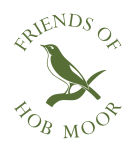Skylarks and meadow pipits
One of the key reasons for Hob Moor being a Local Nature Reserve is that it has significant breeding populations of skylark and meadow pipit. The tussocky pasture with scattered bushes and mown sports pitches, provide a mosaic of different grassland which forms an ideal habitat for these groundnesting birds.
The meadow pipit is smaller than the skylark, being about 14.5cm long as compared to 18cm; both birds have rather sombre brown plumage but the skylark has a slight crest.
Birdsong
Although visually the two species look similar, the songflights are very different: when a meadow pipit takes off, it appears to do so with difficulty, hesitating and then not rising far; it glides down with open wings. The skylark rises vertically, often several hundred metres, and then hovers for several minutes before descending vertically, singing all the while. It lands in the vicinity of its nest and then runs through the cover of the grass to reach it, unseen by predator birds. It is almost always the male who sings. The reason skylarks sing is for attraction during the mating season. They sing from around April to late-July, preferably on warm sunny days, but can sometimes be heard singing in late winter.
Skylark song: To hear a skylark recorded singing above Hob Moor in June 2009, click the arrow below. [to be added]
Habitat
Because they are groundnesting, both skylarks’ and meadow pipits’ nests could be easy prey to their predators (crows, magpies, rooks). They will not nest near places where predators can perch and watch where they take-off from and land. Therefore, they nest in open ground and avoid being within a hundred metres of trees, hedges or even goal posts so their breeding territories are grouped around the centre of the Moor. Each pair will have their own defended territory. The nest is shallow and built in open, short to medium height grass, whereas the meadow pipit will build its nest in taller grass.
Population
The UK population of skylarks has dropped by half in the last 20 years and are considered red-listed. The meadow pipit numbers haven’t declined quite so much, but they are still amber-listed. Recent surveys of the breeding territories of both meadow pipits and skylarks on Hob Moor have shown that both species are well established. In 2000, there were at least ten breeding pairs of meadow pipit, the territories being both on the greater part of the main area of the Moor and on the south-western area between the Baths and Our Lady’s School. In the same year, five breeding territories of skylarks were mapped, with a further one being abandoned. By 2003, this number had increased to six, possibly seven; the increase may well have been due to the reduction in the number of sports pitches being mown, the felling of two stands of trees which had been planted near to the centre of the Moor, and a more appropriate regime regarding the cutting of the thistles. There was a drop in numbers in 2006, but by 2007 there seemed to be around 6 pairs again. In order not to disturb the birds, no actual nests are ever identified, just their individual territories.

Other birds
Many other birds can be seen on Hob Moor. Kingfishers visit the becks; linnets and other finches feed on the thistle-seeds; common and blackheaded gulls loaf on the mown areas from autumn through to spring; wrens sing loudly in the boundary hedges; kestrels and sparrowhawks hunt frequently; and the Triangle area is particularly important, especially for whitethroat, blackcap, garden warbler and bullfinch. Swallows and housemartins are seen in their feeding flights from April to October, with swifts also present from May to August; the open sky above Hob Moor is the ideal place to observe these birds in large and small numbers. Also, although there has recently been a steep decline in numbers of starlings, they are abundant around Hob Moor, due to the combination of a large area of permanent pasture where they can feed on invertebrates and houses and gardens where they nest and feed on scraps. In addition, there is a small but regular roost of corn buntings which gathers in winter in grass tussocks and bushes.
To hear a recording of the dawn chorus from May 2011, click the arrow below. [to be added]
There is much on the Moor to interest the bird-watcher. For many people, however, the skylark is the most important bird, its song being the spirit of Hob Moor.
Birds sighted regularly
Blackbird, Bullfinch, Chaffinch, Carrion Crow, Collared Dove, Dunnock, Fieldfare, Goldfinch, Greenfinch, Blackheaded Gull, Common Gull, Jackdaw, Linnet, Magpie, Mallard, Housemartin, Meadow Pipit, Redwing, Robin, Rook, Skylark, House Sparrow, Sparrowhawk, Starling, Swallow, Swift, Mistle Thrush, Song Thrush, Blue Tit, Coal Tit, Great Tit, Long-tailed Tit, Wood-pigeon, Wren, Yellowhammer.
Less frequent sightings
Blackcap, Corn Bunting, Reed Bunting, Cuckoo, Stock Dove, Goldcrest, Heron, Jack Snipe, Kestrel, Kingfisher, Merlin, Redpoll, Green Sandpiper, Siskin, Snipe, Treecreeper, Grey Wagtail, Yellow Wagtail, Garden Warbler, Willow Warbler, Wheatear, Whitethroat, Woodcock, Greater Spotted Woodpecker.




